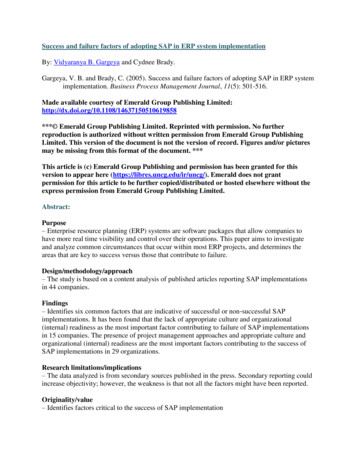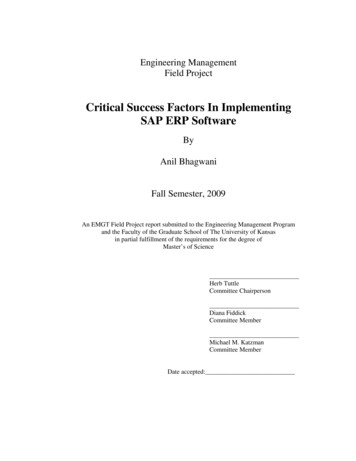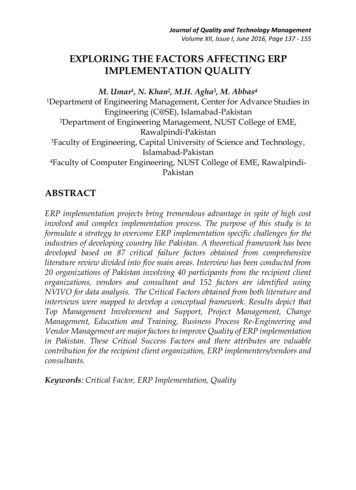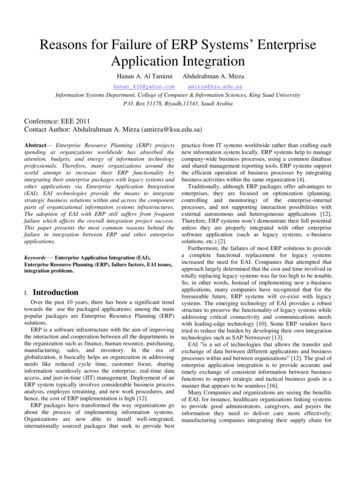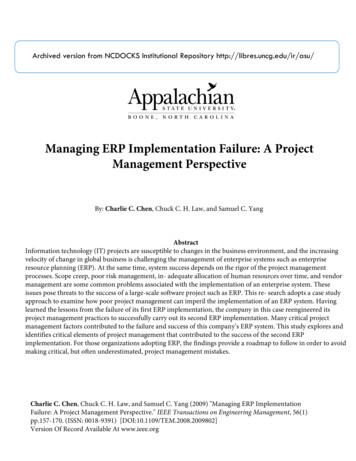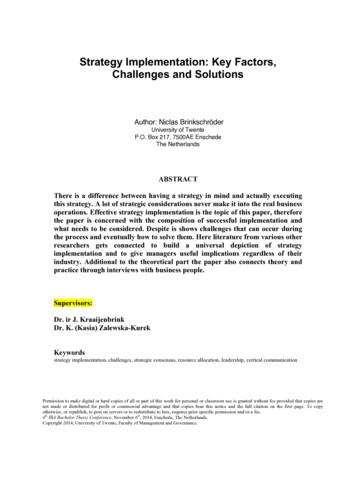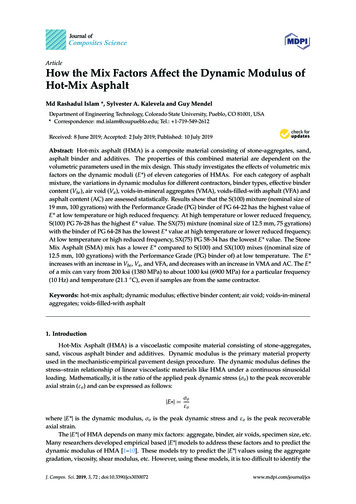
Transcription
Critical Failure Factors in ERP ImplementationAda WongThe University of Hong KongThe University of Warwick, UKisada@business.hku.hkPatrick Y.K. ChauThe University of Hong Kongpchau@business.hku.hkHarry ScarbroughThe University of Warwick, UKHarry.Scarbrough@wbs.ac.ukRobert DavisonCity University of Hong Kongisrobert@cityu.edu.hkAbstractThis study firstly examines the current literature concerning ERP implementation problemsduring implementation phases and causes of ERP implementation failure. A multiple casestudy research methodology was adopted to understand “why” and “how” these ERPsystems could not be implemented successfully. Different stakeholders (including topmanagement, project manager, project team members and ERP consultants) from these casestudies were interviewed, and ERP implementation documents were reviewed fortriangulation. An ERP life cycle framework was applied to study the ERP implementationprocess and the associated problems in each phase of ERP implementation. Fourteen criticalfailure factors were identified and analyzed, and three common critical failure factors (poorconsultant effectiveness, project management effectiveness and poo555îr quality of businessprocess re-engineering) were examined and discussed.Future research on ERPimplementation and critical failure factors is discussed. It is hoped that this research willhelp to bridge the current literature gap and provide practical advice for both academics andpractitioners.Keywords: Critical Failure Factors, ERP Implementation, ERP Life Cycle.1. IntroductionAn ERP system is an integrated software solution, typically offered by a vendor as a packagethat supports the seamless integration of all the information flowing through a company, suchas financial, accounting, human resources, supply chain, and customer information(Davenport, 1998). ERP implementation is a lengthy and complex process, and there havebeen many cases of unsuccessful implementations (Parr and Shanks, 2000), which have hadmajor impacts on business performance. As ERP plays a very important role in business,ERP implementation and its critical issues, success factors and implementation problemshave been investigated in the past (Parr and Shanks, 2000; Majed et al., 2003; Soh et al.,2000; Sumner, 2000).Prior research has shown that conflict with consultants is one of the main managerialproblems during the implementation period of ERP system (Themistocleous et al., 2001).Consultants can bring to the organisation specialised skills, experience, and know-how thatthe organisation needs when it is both time-consuming and expensive for it to build internally(Gable, 2003). They can also offer a firm-wide view, encourage unity between members, and492
they are usually neutral (Davenport, 1998). ERP implementation is by no means a purelytechnical system implementation, and will include Business Process Reengineering (BPR).Consultants can perform the role of change facilitator and are involved in very importantknowledge transfer. Consulting firms use techniques such as guided learning, formal trainingand knowledge creation activities to direct clients to the necessary knowledge required for asuccessful implementation. This guidance saves the client considerable time and effort inknowledge search costs (Gable, 2003).It has been found that the mismatch between ERP and organization can have significantimpacts on organizational adoption, and this could be the main reason causing the ERPimplementation failure (Umble et al., 2003). The need for greater customization of ERPsoftware will increase in this case, and the risks associated with the ERP implementation willbe much higher (Soh et al., 2000). According to Soh et al. (2000), there could be differentlevels of mismatch, namely business function, data and output. Careful selection andevaluation of ERP systems is required in order to reduce the potential risk of softwaremismatch.Different ERP implementation phases are associated with specific ERP implementationproblems (Markus et al., 2000). The ERP implementation literature has provided a solidtheoretical background to ERP research. However, our review of literature suggests thatthere seems to be insufficient research investigating the failure factors of ERPimplementation from planning to post ERP implementation. Further in-depth research hereseems justified in order to provide useful information for practitioners and a researchframework for understanding critical factors and how those factors influence ERPimplementation. This study aims at achieving the following objectives: examining theprocess of ERP implementation based on an “ERP System Life Cycle” (Markus et al., 2000);and identifying the factors contributing towards ERP implementation failure.This paper is organized into three sections. Firstly, a review of current literature on ERPimplementation is presented, and gaps are identified in the literature investigating failurefactors in ERP implementation. Secondly, a detailed examination of ERP implementationproblems based on case studies is presented. Thirdly, critical failure factors are discussed andexamined. This leads to research contributions and future research directions.2. Background and Literature ReviewThere have been many reports of unsuccessful ERP implementations within business,including accounts of the inability of Hershey to ship candy at Halloween, Nike losing shoeorders, and Foxmeyer’s failure to process orders (Cotteleer, 2003). Majed (2000) reportedthat 70% of ERP implementations did not achieve their estimated benefits. In other studies,the percentage of ERP implementations that can be classified as “failures” ranges from 40%to 60% or higher (Langenwalter, 2000), and failures of ERP system implementation projectshave been known to lead to problems as serious as organizational bankruptcy (Bulkelery,1996; Davenport, 1998; Markus et al., 2000).Practitioners tend to discuss the impact of the failure of ERP implementation in a relativesense, referring to the shutting down of the system, being able to use only part of the ERP493
system, suffering business loss, dropping market price, losing both market share andcompetitive advantage due to implementation failure, and so on (Deutsch, 1998; Diederich,1998; Nelson and Ramstad, 1999). However, there have been various definitions of failure ofERP implementation. Failure has been defined as an implementation that does not achieve asufficient Return On Investment (ROI) identified in the project approval phase. Using thisdefinition, it has been found that failure rates are in the range of 60–90% (Ptak, 2000).As ERP implementation failure rates are so high and the consequent impacts are sodetrimental to business, there is a compelling reason for opening the “black box” toinvestigate the factors causing failure. In order to examine the causes of failure in the ERPimplementation process, an “ERP System Life Cycle” (Markus et al., 2000) perspective wasadopted, that can help to look at what goes on (e.g., problems experienced and attempts atproblem resolution) at each phase of the experience cycle (Markus et al., 2000). Previousresearch has focused on IS implementation for the definition of IS failure (Lyytinen, 1988).However, the majority of studies have failed to take into account the richness of the ERPfailure phenomenon. In this study, we have conducted empirical investigations into ERPfailure from the perspectives of management, the project team, and the consultants involvedin ERP implementation. We define critical failure factors (CFFs) as the key aspects (areas)where “things must go wrong” in order for the ERP implementation process to achieve a highlevel of failure.3. Research MethodologyA case study method has been adopted for determining the specific CFFs, “how” theyinfluence the effectiveness of ERP implementation, and for concluding “why” the factors ledto failure and “how” they influenced ERP implementation failure. The case study, as aresearch strategy “attempts to examine a contemporary phenomenon in its real-life context,especially when the boundaries between phenomenon and context are not clearly evident(Yin, 2003).” Thus, the case study method can help to acquire rich data for exploring howCFFs in different ERP implementation phases affect ERP implementation failure.Based on a case study methodology (Yin, 2003), a research protocol was established drawingon a literature framework. The protocol was critically evaluated and reviewed by industrialpractitioners to ensure that the protocol design is appropriate for answering the researchquestion. All interview results were taped, transcribed and reviewed by a research assistant.The resulting interview transcription was reviewed by the interviewees to confirm the internalreliability of the research study. During the case interviews, each of the interviewees wasasked to suggest a set of critical failure factors. Data were collected during 2003-04 fromsemi-structured interviews. Top management, project managers and project team members(such as the IT manager, logistics manager, production and logistics supervisor, seniorlogistics manager and external ERP consultant) were interviewed. Data triangulation wasconducted to increase the reliability of the study. All the written documentation regarding theorganization’s ERP implementation process was accessed and examined. These includemeeting minutes, email communications, proposals, ERP project related presentationmaterials, implementation documents, intranet and knowledge management systems (systemsthat store, manage and disseminate ERP related knowledge). As the respective intervieweesevaluated the systems based on different perspectives, judgment was provided and this wasreviewed and confirmed by the chief informant (e.g., project manager) of the company. By494
conducting data triangulation and building a chain of evidence in research database, thefactors acquired from the different interviewees were verified and evaluated. After all thedata were input into the textual table for multiple case studies comparison, specific patternscould be identified and findings could be summarized (Yin, 2003).4. Research FrameworkMany organizations appear to underestimate the issues and problems often encounteredthroughout the ERP life cycle (Markus et al., 2000). Understanding life cycle managementissues will also help to direct the ERP research agenda (Chang et al., 2000). A number ofphase models in the literature suggest that a specific focus is required within the variousstages of ERP implementation. For example, Markus et al. (2000) developed a four-phaseprocess model of ERP implementation consisting of a project phase, shakedown phase, andan onward and upward phase. Also, Parr and Shanks (2000) in examining the actualimplementation process, presented a project-phase model. This provides a useful templatefor organizations planning ERP implementation. Several researchers have developed processmodels of ERP implementation. In this section we review three of those models. A companymust focus on, evaluate and define relevant company processes in precise detail in order toimplement an ERP system. Implementing the ERP system involves a process that begins withplanning for the system. After planning is completed, a project team embarks on and thenmoves through a number of distinct project phases. After the system is up and running, theremay be a post-implementation review and later a stabilization phase. As several authors(Markus et al., 2000; Parr and Shanks, 2000) have stated, the implementation process of anERP system is best conceptualized as a business project rather than the installation of a newsoftware technology.Bancroft et al. (1998) presented a view of the implementation process which was derivedfrom research involving discussions with 20 practitioners and from studies of threemultinational corporation implementation projects. The Bancroft et al. (1998) model has fivephases: focus, as is, to be, construction and testing, and actual implementation. The “focus”phase can be seen as a planning phase involving the setting-up of the steering committee,selection and structuring of the project team, development of the project’s guiding principles,and creation of a project plan. The “as is” phase involves the analysis of current businessprocesses, installation of the ERP technology, mapping of business processes on to the ERPfunctions, and training the project team. The “to be” phase entails high-level design, and thendetailed design which is subject to user acceptance, followed by interactive prototypingaccompanied by constant communication with users.Ross (1998) has developed a five-phase model based on 15 case studies of ERPimplementation. The phases of this model are; design, implementation, stabilization,continuous improvement and transformation. The design phase is a planning phase in whichcritical guidelines and decision making for implementation are determined. Ross’ (1998)implementation covers several of Bancroft et al.’s (1998) phases: as is, to be, constructionand testing, and actual implementation. Ross’ (1998) stabilization phase occurs after cutover, and is a period of time for fixing problems and improvement of organizationalperformance. This is followed by a continuous period of steady improvement whenfunctionality is added. Finally, transformation occurs when organizational boundaries andsystems are maximally flexible.495
Markus et al., (2000) developed a four-phase model of ERP implementation: chartering,project, shake-down and an onwards and upwards phase. The chartering phase begins beforeBancroft et al.’s (1998) focus and Ross’ (1998) design phases. It includes the development ofthe business case for the ERP, package selection, identification of the project manager, andbudget and schedule approval. The description of their project phase is similar to Ross’(1998) project phase and it covers four of Bancroft et al.’s (1998
ERP implementation. Failure has been defined as an implementation that does not achieve a sufficient Return On Investment (ROI) identified in the project approval phase. Using this definition, it has been found that failure rates are in the range of 60–90% (Ptak, 2000). As ERP implementation failure rates are so high and the consequent impacts are so
